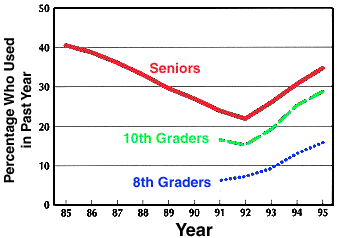 |
News
Volume 11, Number 1
January/February 1996 |
Student's Use of Marijuana, Other Illicit Drugs, and Cigarettes Continued to Rise in 1995
By Robert Mathias, NIDA NOTES Staff Writer
Illicit drug use and tobacco use among America's young people increased again last year, continuing a trend that began in the early 1990s, according to NIDA's 1995 Monitoring the Future study. Marijuana use showed the sharpest increase among illicit drugs, but more of the Nation's 8th-, 10th-, and 12th-grade students also reported using other illicit drugs in 1995.

Marijuana use among the Nation's 8th-, 10th-, and 12th-grade students
rose in 1995, continuing a trend that began in the early 1990's. The
graph shows past-year use of marijuana since 1985 for 12th graders
and since 1991 for 8th and 10th graders, who were surveyed for the
first time that year.
The figures indicate that American teenagers are "a generation at risk," Health and Human Services Secretary Dr. Donna E. Shalala said at a press conference held last December to release the results of the survey. Although drug use is still far below the peak levels of the late 1970s, "Trends are unmistakably headed the wrong way," Secretary Shalala said.
The 1995 survey found that from 1991 to 1995, the percentage of 8th graders who had used an illicit drug in the 12 months prior to the survey (referred to as annual use) had almost doubled, rising from 11.3 percent to 21.4 percent. Since 1992, annual use of any illicit drug has risen from 21.4 percent to 33.3 percent among 10th graders and from 29.4 percent to 39.0 percent among high school seniors.
Cigarette smoking rose significantly among 10th and 12th graders, the survey indicated. The proportion of 10th graders who reported smoking cigarettes in the 30 days prior to the survey (referred to as current use) rose from 25.4 percent in 1994 to 27.9 percent in 1995. Current use of cigarettes among 12th graders climbed from 31.2 percent to 33.5 percent. Rates of alcohol use, which have stabilized at high levels in recent years, held steady among students in all three grades in 1995. (For more details, see Drug Use Among 8th, 10th, and 12th Graders (table))
The resurgence of illicit drug use and cigarette use among young people, which began in the early 1990s, is tied to decreases in the proportion of students who see drugs as dangerous, say researchers from the University of Michigan's Institute for Social Research who conducted the survey. The researchers point in particular to a sharp decline at all three grade levels in the perceived risks of using marijuana, which has been mirrored by a corresponding rise in marijuana use. Since 1991, the percentage of students who thought that regular marijuana users run a great risk of harming themselves physically or in other ways has dropped from 78.6 percent to 60.8 percent among 12th graders, from 82.1 percent to 67.9 percent among 10th graders, and from 83.8 percent to 73.0 percent among 8th graders. During this same 4-year period, annual marijuana use rose from 23.9 percent to 34.7 per-cent among 12th graders, from 16.5 percent to 28.7 percent among 10th graders, and from 6.2 percent to 15.8 percent among 8th graders.
"We are particularly concerned at these increases, especially among 8th graders. The younger children are when they initiate drug use, the more likely they are to become heavy users and to experience the serious consequences of such abuse," said NIDA Director Dr. Alan I. Leshner.
However, NIDA's studies on resistance to drug use among youths show that a number of approaches can help prevent drug abuse among young people, Dr. Leshner said. This research has shown that positive parental involvement as well as comprehensive community prevention approaches involving adults, peers, schools, and community organizations can reduce drug, tobacco, and alcohol use among adolescents, Dr. Leshner stated.
From NIDA NOTES, January/February, 1996
[NIDA Home Page][NIDA NOTES Index][1996 Archive Index Index]
|